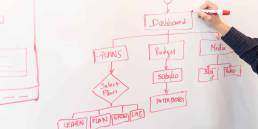Chapter 11 of the Lean Start-Up | Adapt
This is a summary of the final chapters of Eric Ries’ The Lean Startup. Chapter 11 focuses on building an adaptive organization while chapter 12 is on sustaining innovation.
Building an Adaptive Organization
An adaptive organization can respond and adjust effectively to changes in its external environment, market, customer preferences, and other factors that can impact business.
Characteristics of an Adaptive Organization
The following characteristics are indicative of an adaptive organization.
- Flexibility: An adaptive company can change its business approach in response to changes in the market or industry.
- Innovation: Adaptive organizations are highly innovative and welcoming of new ideas and technologies. They promote an intrapreneurial culture among their employees and foster an environment where people feel motivated to contribute to the development of creative ideas.
- Adaptive organizations react swiftly and efficiently to change. That is, these organizations are quick to make changes to improve the value they deliver to customers.
- Customer-Centric Approach: Customer satisfaction is a top priority. There is a great emphasis on understanding and meeting the needs of customers. They regularly conduct market research, collect feedback, and adjust their products as needed.
- Data-Driven Decision-Making: Adaptive companies use data and analytics to guide their decision-making processes.
“5-Why” Technique
One of the key concepts of Chapter 11 is the “5-Why” Technique
The 5-Why analysis involves analyzing a problem by asking why it failed until you get to the root cause. For example, a certain process at your organization has failed. You ask the owner of the process why the process failed. They will give a reason; which might be the cause of the observed failure. You then ask what led to that preceding situation. Essentially, you are drilling down based on their feedback until you get to the root cause of the problem. The “5 Whys” technique is more of a guideline than a hard and fast rule. The number five is not a magical number, and stopping at exactly five rounds is not always required. The goal is to ask “Why” until you find the problem’s root cause or are no longer getting meaningful feedback.
However, when it comes to allocating resources for problem-solving, Eric Ries believes in a more proportional or equitable approach. Here are two quotes from the chapter about how to use the 5-Why technique:
“Consistently make proportional investments at each level of the hierarchy.”
“We don’t make large investments in prevention unless we are coping with a large problem.”
This means we are putting some resources into tackling the problem at each level of the 5-why hierarchy. Secondly, our investments to prevent those problems need to be proportional.
Common Pitfalls of Using 5-Why Analysis
The 5-why analysis is difficult to implement in practice. Eric Ries points out that, “Instead of asking why repeatedly in an attempt to understand what went wrong, frustrated teammates start pointing fingers.”
The author then offers some tactics to avoid this problem:
Include Everyone Affected By The Problem
“Include the person who discovered the problem, the person who tried to fix the symptom, and anyone who worked on the features involved. Also, include anyone who escalated the problem.”
- The person who discovered the problem is likely to have valuable insights into what the problem is.
- The person who tried to fix the problem can provide valuable insights regarding what attempts were made to fix the problem and why those failed.”
Ensure There Is Mutual Trust
“[Ensure you have] an environment of mutual trust”
The absence of trust discourages open communication among colleagues. In a trusting environment, team members are more willing to share their ideas, experiences, and insights without fear of repercussion. Moreover, most people will be reluctant to admit their mistakes or offer information honestly if they believe their jobs may be at risk.
Include an Authority Figure
“An authority figure must be present to ensure the process is completed. It’s usually very challenging for individuals.”
An authority figure people trust is also essential for a successful 5-why analysis session.
Where you are unable to meet these aforementioned recommendations Eric Ries suggests a simplified approach such as conducting a CAPA. Corrective Action, Preventive Action. The goal of CAPA is to prevent the recurrence of an issue and improve overall quality.
Furthermore, Start small. Don’t go for all the issues. Be very specific. And use it only for new problems.
Chapter 11 also elaborates on the following adaptive techniques
Adapt to Smaller Batches
Instead of focusing on large projects, teams concentrate on creating smaller increments of a product. This allows for faster feedback loops and helps the team to learn from each iteration while making improvements along the way. Moreover, breaking large product development projects into smaller tasks/phases minimizes the overall risk associated with product development. It’s easier to control and address issues when the scope of work is smaller.
Related to the idea of having smaller batches, are shorter cycle times and faster customer feedback loops.
- Shorter cycle times: Faster iterations also mean a faster feedback loop.
- Faster customer feedback means faster value delivery and a reduced time-to-market.
Empower Teams to Make Fast and Courageous Decisions
This means providing teams with the authority to make decisions autonomously. This entails removing bureaucratic impediments and fostering an environment where people feel empowered to pursue creative ideas at work. Furthermore, having a culture that appreciates and rewards innovation is vital.
Chapter 12 of the Lean Startup | Innovate
Chapter 12 explores how to nurture disruptive innovation. The following are the key highlights of this chapter.
Secure Your Scarce Resources
That is, ensure nothing happens to your budget. The term “secure” implies that measures are in place to protect and conserve your financial resources. In this context, security can entail putting financial controls in place, risk management techniques, or having a financial allocation policy to ensure resources are used properly and not wasted, mismanaged, or misused.
Independent Development Authority
Complete autonomy to develop and market new products. They have to be able to conceive and execute experiments without having to gain an excessive number of approvals.
What Autonomous Teams Look Like
These are Eric Ries’ recommendations for nurturing an autonomous team and managing an innovation sandbox.
- Completely cross-functional team
- Team members have some personal stake in the product outcome: Stock options or recognition.
Creating an Innovation Sandbox
-
- One team must see the entire experiment through from start to finish.
- No experiment can run longer than a specific period
- No experiment can affect more than a specified number of customers
- Every experiment must be evaluated on 5-10 actionable metrics
Start-up Expansion
Let’s elaborate on some key aspects of start-up expansion as mentioned in the final chapter of the Lean Startup by Eric Ries.
Public image of the company
As a startup grows, the public image of the company becomes more important. This means keeping a good reputation and actively developing the brand. This is done via effective marketing campaigns, public relations, and community engagement to create a positive perception of the company.
Rise of competition
It’s important to expect competition as the market develops and demand increases. So, organizations must continuously monitor their competitive landscape for new threats or opportunities.
Product Maturation
Extending the product lifecycle through line extensions or by introducing new features (incremental upgrades). This could stem from the need to cater to a different market segment or as a result of geographical expansion.
Operational Cost and Legacy Products
Operational costs may rise as the business expands. Implementing efficiency measures, such as outsourcing non-core operations, automating procedures, and streamlining supply chain processes, can help to reduce costs and increase overall efficiency. Also, the management will need to decide how to manage legacy products. Sometimes, they are divested to other companies, or maintained for other strategic reasons.


